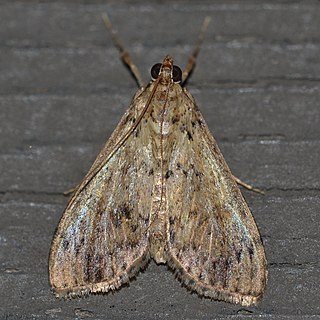
Crambidae comprises the grass moth family of lepidopterans. They are variable in appearance, with the nominal subfamily Crambinae taking up closely folded postures on grass stems where they are inconspicuous, while other subfamilies include brightly coloured and patterned insects that rest in wing-spread attitudes.

Spilomelinae is a very species-rich subfamily of the lepidopteran family Crambidae, the crambid snout moths. With 4,135 described species in 344 genera worldwide, it is the most speciose group among pyraloids.

Asciodes is a genus of snout moths in the subfamily Spilomelinae of the family Crambidae. The genus was erected by Achille Guenée in 1854 with Asciodes gordialis as type species.
Asturodes is a genus of snout moths in the subfamily Spilomelinae of the family Crambidae. The genus is placed in the tribe Margaroniini.
Hoploscopa is a genus of snout moths in the subfamily Hoploscopinae of the family Crambidae. The genus was described by Edward Meyrick in 1886, with Hoploscopa astrapias as type species.
Hydropionea is a genus of moths of the family Crambidae. The 13 described species are distributed in Central and South America.

Mnesictena is a genus of snout moths in the subfamily Spilomelinae, where it is placed in the tribe Udeini. The genus was erected by the English entomologist Edward Meyrick in 1884. The currently known seven species are exclusively found on New Zealand and the associated Antipodes Islands and Chatham Islands.

Nagiella is a genus of moths of the family Crambidae. It was established by Eugene G. Munroe in 1964 as a replacement name for NagiaWalker, 1866, a name that was preoccupied by NagiaWalker, 1858 in the Lepidoptera family Erebidae.

Placosaris is a genus of snout moths in the subfamily Pyraustinae of the family Crambidae. It is placed in the tribe Pyraustini.

Catharia is a monotypic moth genus described by Julius Lederer in 1863. It contains the single species Catharia pyrenaealis described by Philogène Auguste Joseph Duponchel in 1843. It is found in Central Europe.

Glaphyriinae is a subfamily of the lepidopteran family Crambidae. It was described by William Trowbridge Merrifield Forbes in 1923. The subfamily currently comprises 509 species in 75 genera.

Mnesictena notata is a moth in the family Crambidae. It was described by Arthur Gardiner Butler in 1879. It is endemic to New Zealand.
Lathrotelinae is a subfamily of the pyraloid family Crambidae described by John Frederick Gates Clarke in 1971. It currently comprises 45 species in six genera.

Lineodini is a tribe of the species-rich subfamily Spilomelinae in the snout moth family Crambidae.

Wurthiini is a tribe of the species-rich subfamily Spilomelinae in the pyraloid moth family Crambidae.

Trichaeini is a tribe of the species-rich subfamily Spilomelinae in the pyraloid moth family Crambidae. The tribe was erected by Richard Mally, James E. Hayden, Christoph Neinhuis, Bjarte H. Jordal and Matthias Nuss in 2019.
Malickyella is a genus of snout moth in the species-rich subfamily Spilomelinae of the family Crambidae. The genus was described in 2010 by the German entomologists Wolfram Mey and Wolfgang Speidel based on material from South-East Asia. The four species of the genus are distributed in the lowland forests of the Indomalayan realm, stretching from the Indian state of Assam to the Philippines.
Mayickyella lobophoralis is a snout moth in the subfamily Spilomelinae of the family Crambidae. It was described by George Hampson in 1896 in the genus Ambia based on specimens collected in the Indian states of Sikkim and Nagaland.
Malickyella tigridalis is a snout moth in the subfamily Spilomelinae of the family Crambidae. It was described by George Hampson in 1897 in the genus Ambia based on specimens collected on Borneo.
Erupinae is a subfamily of the lepidopteran family Crambidae. It was described by Eugene G. Munroe in 1995.











